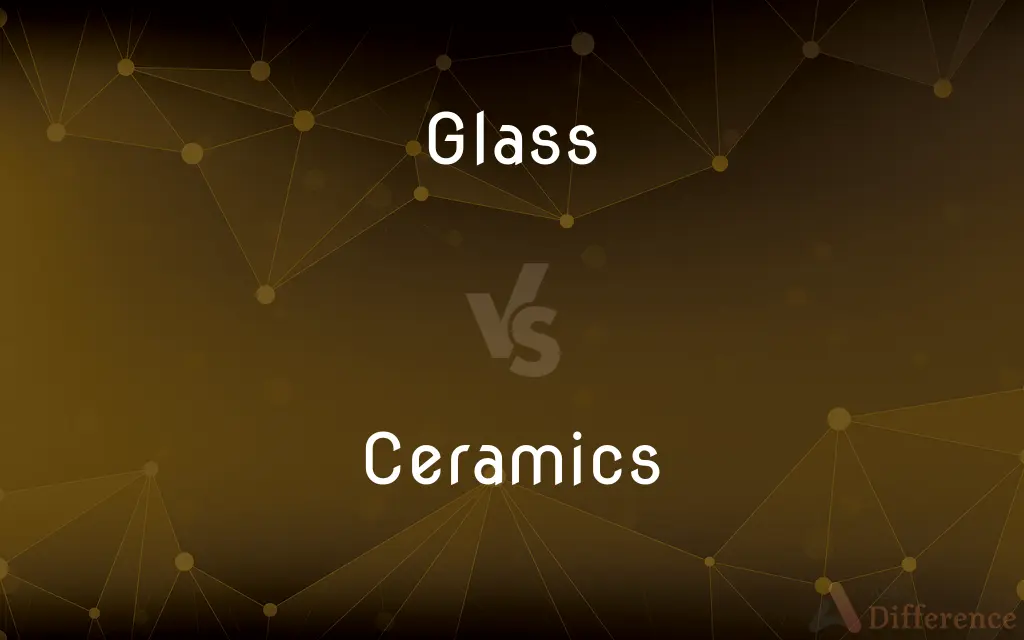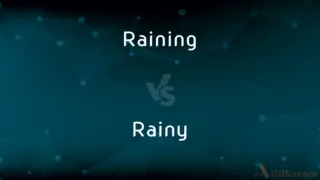Glass vs. Ceramics — What's the Difference?
By Maham Liaqat & Urooj Arif — Updated on March 20, 2024
Glass is a smooth, transparent material made by melting sand, while ceramics are diverse, often porous materials made from clay that's fired.

Difference Between Glass and Ceramics
Table of Contents
ADVERTISEMENT
Key Differences
Glass is known for its smooth, transparent, and uniform structure, created by rapidly cooling melted silica. Ceramics, on the other hand, are crafted from clay and other natural materials that are shaped and then fired in a kiln at high temperatures, resulting in a wide range of textures and properties.
While glass typically exhibits transparency and a non-crystalline structure, ceramics can be either opaque or translucent and generally possess a crystalline or partly crystalline structure. This fundamental difference in structure and appearance makes glass preferred for items needing clarity, like windows and bottles, whereas ceramics are chosen for their durability and heat resistance in products like pottery and tiles.
Glass's amorphous structure lends it unique optical properties and a smooth surface that's easy to clean, making it ideal for applications requiring visibility and hygiene, such as in laboratory equipment and kitchenware. Ceramics, with their varied composition, can be engineered for high strength, thermal insulation, and chemical resistance, which is why they're used in a broad array of applications from dinnerware to aerospace components.
The production process of glass involves melting and rapid cooling, which results in a uniform and homogenous material. Ceramics' production, involving shaping and firing, allows for intricate designs and shapes, enabling a vast range of artistic and practical applications. The ability to add glazes and decorations to ceramics further distinguishes them from glass by enhancing their aesthetic and functional properties.
Environmental impact and sustainability are increasingly important considerations, with glass being highly recyclable and ceramics offering longevity and durability. While glass recycling is efficient and reduces the demand for raw materials, ceramics' long lifespan and resistance to wear contribute to waste reduction by necessitating fewer replacements.
ADVERTISEMENT
Comparison Chart
Composition
Made from melted silica (sand)
Made from clay and other natural materials
Structure
Amorphous (non-crystalline)
Crystalline or partly crystalline
Transparency
Transparent or translucent
Opaque, some can be translucent
Production Process
Melting and rapid cooling
Shaping and firing in a kiln
Main Uses
Windows, bottles, lab equipment
Pottery, tiles, insulators, aerospace components
Thermal Resistance
Lower thermal resistance
Higher thermal resistance
Durability
Less durable compared to some ceramics
Can be very durable, depending on type
Recyclability
Highly recyclable
Less recyclable but offers longevity
Compare with Definitions
Glass
Smooth Surface.
The smooth surface of glass makes it ideal for hygiene in kitchenware.
Ceramics
Heat Resistance.
Ceramic tiles are used in space shuttles for their heat resistance.
Glass
Optical Clarity.
Optical lenses are made from glass for its excellent clarity and light transmission.
Ceramics
Durability.
High-strength ceramics are used in bulletproof vests and aerospace engineering.
Glass
Thermal Conductivity.
Glass's thermal conductivity makes it less suited for high-temperature applications.
Ceramics
Artistic Applications.
Pottery is crafted from ceramics for its aesthetic and functional qualities.
Glass
Transparent Material.
Glass is used in windows for its clear, transparent properties.
Ceramics
Sustainability.
Ceramic products, like dinnerware, offer longevity, reducing the need for frequent replacements.
Glass
Recyclability.
Glass bottles can be recycled, reducing the need for raw material extraction.
Ceramics
Any of various hard, brittle, heat-resistant and corrosion-resistant materials made by shaping and then firing a nonmetallic mineral, such as clay, at a high temperature.
Glass
Glass is a non-crystalline, often transparent amorphous solid, that has widespread practical, technological, and decorative use in, for example, window panes, tableware, and optics. Glass is most often formed by rapid cooling (quenching) of the molten form; some glasses such as volcanic glass are naturally occurring.
Ceramics
An object, such as earthenware, porcelain, or tile, made of ceramic.
Glass
A hard, brittle substance, typically transparent or translucent, made by fusing sand with soda and lime and cooling rapidly. It is used to make windows, drinking containers, and other articles
The screen is made from glass
A glass door
Ceramics
Ceramics (used with a sing. verb) The art or technique of making objects of ceramic, especially from fired clay.
Glass
A drinking container made from glass
A beer glass
Ceramics
Plural of ceramic
Glass
A lens, or an optical instrument containing a lens or lenses, in particular a monocle or a magnifying lens.
Ceramics
The art or science of making ceramic objects.
Glass
A mirror
She couldn't wait to put the dress on and look in the glass
Ceramics
Ceramic objects as a group.
Glass
Cover or enclose with glass
The inn has a long gallery, now glassed in
Ceramics
The art of making things of baked clay; as pottery, tiles, etc.
Glass
(especially in hunting) scan (one's surroundings) with binoculars
The first day was spent glassing the rolling hills
Ceramics
Work formed of clay in whole or in part, and baked; as, vases, urns, etc.
Glass
Hit (someone) in the face with a beer glass
He glassed the landlord because he'd been chatting to Jo
Ceramics
The art of making and decorating pottery
Glass
Reflect as if in a mirror
The opposite slopes glassed themselves in the deep dark water
Ceramics
Diverse Textures.
Ceramics range from rough terracotta to smooth porcelain.
Glass
Any of a large class of materials with highly variable mechanical and optical properties that solidify from the molten state without crystallization, are typically made by silicates fusing with boric oxide, aluminum oxide, or phosphorus pentoxide, are generally hard, brittle, and transparent or translucent, and are considered to be supercooled liquids rather than true solids.
Glass
A drinking vessel.
Glass
A mirror.
Glass
A barometer.
Glass
A window or windowpane.
Glass
The series of transparent plastic sheets that are secured vertically above the boards in many ice rinks.
Glass
Glasses A pair of lenses mounted in a light frame, used to correct faulty vision or protect the eyes.
Glass
Often glasses A binocular or field glass.
Glass
A device, such as a monocle or spyglass, containing a lens or lenses and used as an aid to vision.
Glass
The quantity contained by a drinking vessel; a glassful.
Glass
Objects made of glass; glassware.
Glass
Made or consisting of glass.
Glass
Fitted with panes of glass; glazed.
Glass
To enclose or encase with glass.
Glass
To put into a glass container.
Glass
To provide with glass or glass parts.
Glass
To make glassy; glaze.
Glass
To see reflected, as in a mirror.
Glass
To reflect.
Glass
To scan (a tract of land or forest, for example) with an optical instrument.
Glass
To become glassy.
Glass
To use an optical instrument, as in looking for game.
Glass
An amorphous solid, often transparent substance, usually made by melting silica sand with various additives (for most purposes, a mixture of soda, potash and lime is added).
The tabletop is made of glass.
A popular myth is that window glass is actually an extremely viscous liquid.
Glass
Any amorphous solid (one without a regular crystal lattice).
Metal glasses, unlike those based on silica, are electrically conductive, which can be either an advantage or a disadvantage, depending on the application.
Glass
(countable) A vessel from which one drinks, especially one made of glass, plastic, or similar translucent or semi-translucent material.
Fill my glass with milk, please.
Glass
(metonymically) The quantity of liquid contained in such a vessel.
There is half a glass of milk in each pound of chocolate we produce.
Glass
(uncountable) Glassware.
We collected art glass.
Glass
A mirror.
She adjusted her lipstick in the glass.
Glass
A magnifying glass or telescope.
Glass
(sport) A barrier made of solid, transparent material.
Glass
The backboard.
He caught the rebound off the glass.
Glass
(ice hockey) The clear, protective screen surrounding a hockey rink.
He fired the outlet pass off the glass.
Glass
A barometer.
Glass
Transparent or translucent.
Glass frog;
Glass shrimp;
Glass worm
Glass
(obsolete) An hourglass.
Glass
Lenses, considered collectively.
Her new camera was incompatible with her old one, so she needed to buy new glass.
Glass
A pane of glass; a window (especially of a coach or similar vehicle).
Glass
(transitive) To fit with glass; to glaze.
Glass
(transitive) To enclose in glass.
Glass
(transitive) fibreglass To fit, cover, fill, or build, with fibreglass-reinforced resin composite (fiberglass).
Glass
To strike (someone), particularly in the face, with a drinking glass with the intent of causing injury.
Glass
To bombard an area with such intensity (nuclear bomb, fusion bomb, etc) as to melt the landscape into glass.
Glass
(transitive) To view through an optical instrument such as binoculars.
Glass
(transitive) To smooth or polish (leather, etc.), by rubbing it with a glass burnisher.
Glass
To reflect; to mirror.
Glass
(transitive) To make glassy.
Glass
(intransitive) To become glassy.
Glass
A hard, brittle, translucent, and commonly transparent substance, white or colored, having a conchoidal fracture, and made by fusing together sand or silica with lime, potash, soda, or lead oxide. It is used for window panes and mirrors, for articles of table and culinary use, for lenses, and various articles of ornament.
Glass
Any substance having a peculiar glassy appearance, and a conchoidal fracture, and usually produced by fusion.
Glass
Anything made of glass.
She would not liveThe running of one glass.
Glass
A drinking vessel; a tumbler; a goblet; hence, the contents of such a vessel; especially; spirituous liquors; as, he took a glass at dinner.
Glass coaches are [allowed in English parks from which ordinary hacks are excluded], meaning by this term, which is never used in America, hired carriages that do not go on stands.
Glass
To reflect, as in a mirror; to mirror; - used reflexively.
Happy to glass themselves in such a mirror.
Where the Almighty's form glasses itself in tempests.
Glass
To case in glass.
Glass
To cover or furnish with glass; to glaze.
Glass
To smooth or polish anything, as leater, by rubbing it with a glass burnisher.
Glass
A brittle transparent solid with irregular atomic structure
Glass
A glass container for holding liquids while drinking
Glass
The quantity a glass will hold
Glass
A small refracting telescope
Glass
Amphetamine used in the form of a crystalline hydrochloride; used as a stimulant to the nervous system and as an appetite suppressant
Glass
A mirror; usually a ladies' dressing mirror
Glass
Glassware collectively;
She collected old glass
Glass
Furnish with glass;
Glass the windows
Glass
Scan (game in the forest) with binoculars
Glass
Enclose with glass;
Glass in a porch
Glass
Put in a glass container
Glass
Become glassy or take on a glass-like appearance;
Her eyes glaze over when she is bored
Common Curiosities
What is glass made of?
Glass is primarily made of silica (sand), melted and rapidly cooled to form a smooth, transparent material.
Why are ceramics preferred for high-temperature applications?
Ceramics have high thermal resistance, making them suitable for applications that involve high temperatures, such as in furnaces and aerospace components.
What is the environmental impact of glass vs. ceramics?
Glass has the advantage of being highly recyclable, reducing raw material demand, whereas ceramics offer durability and longevity, leading to less frequent replacements.
Why is glass not as durable as ceramics?
Glass is more prone to breaking upon impact due to its amorphous structure, while some ceramics, designed for strength, resist wear and damage better.
What makes glass smooth and easy to clean?
The rapid cooling of melted silica results in a smooth, non-porous surface that doesn't harbor bacteria, making glass easy to clean.
Is thermal conductivity a concern with glass?
Yes, glass's thermal conductivity can be a limitation in applications where insulation is critical, unlike ceramics, which often have low thermal conductivity.
How are glass and ceramics similar?
Both are inorganic, non-metallic materials that undergo a heating process during manufacturing, though their compositions and properties differ significantly.
Can glass be recycled?
Yes, glass is highly recyclable and can be melted down and remolded into new products multiple times.
What are ceramics?
Ceramics are diverse materials made from clay and other natural substances, shaped and fired at high temperatures.
How do glass and ceramics differ in use?
Glass is often used for items requiring transparency, like windows and bottles, while ceramics are chosen for their durability and heat resistance, such as in pottery and tiles.
Can ceramics be decorated?
Yes, ceramics can be glazed and decorated, enhancing their aesthetic appeal and functionality.
Are all ceramics opaque?
While many ceramics are opaque, some, like certain types of porcelain, can be made translucent.
Do ceramics have any optical properties?
While not typically transparent like glass, some ceramics can be engineered for specific optical qualities, such as infrared or ultraviolet resistance.
Can ceramics withstand chemical exposure?
Yes, many ceramics are chemically inert and can withstand exposure to acids, bases, and solvents, making them suitable for chemical processing applications.
What role does the production process play in the properties of glass and ceramics?
The melting and rapid cooling of glass result in a uniform, amorphous structure, while the shaping and firing of ceramics allow for varied textures, densities, and strengths.
Share Your Discovery

Previous Comparison
Nickel vs. Silver
Next Comparison
Raining vs. RainyAuthor Spotlight
Written by
Maham LiaqatCo-written by
Urooj ArifUrooj is a skilled content writer at Ask Difference, known for her exceptional ability to simplify complex topics into engaging and informative content. With a passion for research and a flair for clear, concise writing, she consistently delivers articles that resonate with our diverse audience.
















































